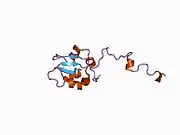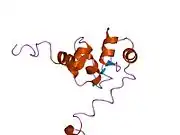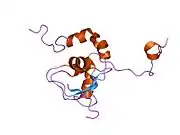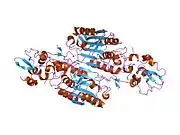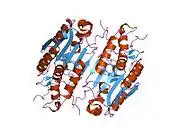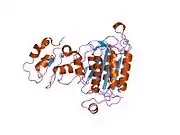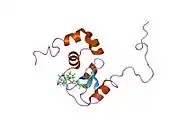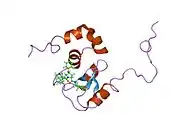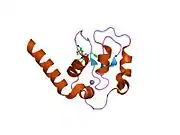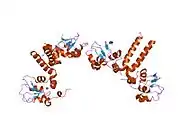X-linked inhibitor of apoptosis protein (XIAP), also known as inhibitor of apoptosis protein 3 (IAP3) and baculoviral IAP repeat-containing protein 4 (BIRC4), is a protein that stops apoptotic cell death. In humans, this protein (XIAP) is produced by a gene named XIAP gene located on the X chromosome.[4][5]
XIAP is a member of the inhibitor of apoptosis family of proteins (IAP). IAPs were initially identified in baculoviruses, but XIAP is one of the homologous proteins found in mammals.[6] It is so called because it was first discovered by a 273 base pair site on the X chromosome.[4] The protein is also called human IAP-like Protein (hILP), because it is not as well conserved as the human IAPS: hIAP-1 and hIAP-2.[4][7] XIAP is the most potent human IAP protein currently identified.[8]
Discovery
Neuronal apoptosis inhibitor protein (NAIP) was the first homolog to baculoviral IAPs that was identified in humans.[4] With the sequencing data of NIAP, the gene sequence for a RING zinc-finger domain was discovered at site Xq24-25.[4] Using PCR and cloning, three BIR domains and a RING finger were found on the protein, which became known as X-linked Inhibitor of Apoptosis Protein. The transcript size of Xiap is 9.0kb, with an open reading frame of 1.8kb.[4] Xiap mRNA has been observed in all human adult and fetal tissues "except peripheral blood leukocytes".[4] The XIAP sequences led to the discovery of other members of the IAP family.
Structure
XIAP consists of three major types of structural elements (domains). Firstly, there is the baculoviral IAP repeat (BIR) domain consisting of approximately 70 amino acids, which characterizes all IAP.[8] Secondly, there is a UBA domain, which allows XIAP to bind to ubiquitin. Thirdly, there is a zinc-binding domain, or a "carboxy-terminal RING Finger".[7] XIAP has been characterized with three amino-terminal BIR domains followed by one UBA domain and finally one RING domain.[9] Between the BIR-1 and BIR-2 domains, there is a linker-BIR-2 region that is thought to contain the only element that comes into contact with the caspase molecule to form the XIAP/Caspase-7 complex.[10] In solution the full length form of XIAP forms a homodimer of approximately 114 kDa.[11]
Function
XIAP stops apoptotic cell death that is induced either by viral infection or by overproduction of caspases. Caspases are the enzymes primarily responsible for cell death.[7] XIAP binds to and inhibits caspase 3, 7 and 9.[12] The BIR2 domain of XIAP inhibits caspase 3 and 7, while BIR3 binds to and inhibits caspase 9.[8] The RING domain utilizes E3 ubiquitin ligase activity and enables IAPs to catalyze ubiquination of self, caspase-3, or caspase-7 by degradation via proteasome activity.[13] However, mutations affecting the RING Finger do not significantly affect apoptosis, indicating that the BIR domain is sufficient for the protein's function.[7] When inhibiting caspase-3 and caspase-7 activity, the BIR2 domain of XIAP binds to the active-site substrate groove, blocking access of the normal protein substrate that would result in apoptosis.[13][14]
Caspases are activated by cytochrome c, which is released into the cytosol by dysfunctioning mitochondria.[7] Studies show that XIAP does not directly affect cytochrome c.[7]
XIAP distinguishes itself from the other human IAPs because it is able to effectively prevent cell death due to "TNF-α, Fas, UV light, and genotoxic agents".[7]
Inhibiting XIAP
XIAP is inhibited by DIABLO (Smac) and HTRA2 (Omi), two death-signaling proteins released into the cytoplasm by the mitochondria.[9] Smac/DIABLO, a mitochondrial protein and negative regulator of XIAP, can enhance apoptosis by binding to XIAP and preventing it from binding to caspases. This allows normal caspase activity to proceed. The binding process of Smac/DIABLO to XIAP and caspase release requires a conserved tetrapeptide motif.[13]
Clinical significance
Deregulation of XIAP can result in "cancer, neurodegenerative disorders, and autoimmunity".[9] High proportions of XIAP may function as a tumor marker.[8] In the development of lung cancer NCI-H460, the overexpression of XIAP not only inhibits caspase, but also stops the activity of cytochrome c (Apoptosis). In developing prostate cancer, XIAP is one of four IAPs overexpressed in the prostatic epithelium, indicating that a molecule that inhibits all IAPs may be necessary for effective treatment.[15] Apoptotic regulation is an extremely important biological function, as evidenced by "the conservation of the IAPs from humans to Drosophila".[4]
Mutations in the XIAP gene can result in a severe and rare type of inflammatory bowel disease.[16] Defects in the XIAP gene can also result in an extremely rare condition called X-linked lymphoproliferative disease type 2.[16][17][18]
Interactions
XIAP has been shown to interact with:
References
- 1 2 3 GRCm38: Ensembl release 89: ENSMUSG00000025860 - Ensembl, May 2017
- ↑ "Human PubMed Reference:". National Center for Biotechnology Information, U.S. National Library of Medicine.
- ↑ "Mouse PubMed Reference:". National Center for Biotechnology Information, U.S. National Library of Medicine.
- 1 2 3 4 5 6 7 8 Liston P, Roy N, Tamai K, Lefebvre C, Baird S, Cherton-Horvat G, Farahani R, McLean M, Ikeda JE, MacKenzie A, Korneluk RG (January 1996). "Suppression of apoptosis in mammalian cells by NAIP and a related family of IAP genes". Nature. 379 (6563): 349–53. Bibcode:1996Natur.379..349L. doi:10.1038/379349a0. PMID 8552191. S2CID 4305853.
- ↑ Duckett CS, Nava VE, Gedrich RW, Clem RJ, Van Dongen JL, Gilfillan MC, Shiels H, Hardwick JM, Thompson CB (June 1996). "A conserved family of cellular genes related to the baculovirus iap gene and encoding apoptosis inhibitors". The EMBO Journal. 15 (11): 2685–94. doi:10.1002/j.1460-2075.1996.tb00629.x. PMC 450204. PMID 8654366.
- ↑ Holcik M, Korneluk RG (July 2000). "Functional characterization of the X-linked inhibitor of apoptosis (XIAP) internal ribosome entry site element: role of La autoantigen in XIAP translation". Molecular and Cellular Biology. 20 (13): 4648–57. doi:10.1128/MCB.20.13.4648-4657.2000. PMC 85872. PMID 10848591.
- 1 2 3 4 5 6 7 Duckett CS, Li F, Wang Y, Tomaselli KJ, Thompson CB, Armstrong RC (January 1998). "Human IAP-like protein regulates programmed cell death downstream of Bcl-xL and cytochrome c". Molecular and Cellular Biology. 18 (1): 608–15. doi:10.1128/MCB.18.1.608. PMC 121528. PMID 9418907.
- 1 2 3 4 Deveraux QL, Reed JC (February 1999). "IAP family proteins--suppressors of apoptosis". Genes & Development. 13 (3): 239–52. doi:10.1101/gad.13.3.239. PMID 9990849.
- 1 2 3 Wilkinson JC, Cepero E, Boise LH, Duckett CS (August 2004). "Upstream regulatory role for XIAP in receptor-mediated apoptosis". Molecular and Cellular Biology. 24 (16): 7003–14. doi:10.1128/MCB.24.16.7003-7014.2004. PMC 479745. PMID 15282301.
- ↑ Huang Y, Park YC, Rich RL, Segal D, Myszka DG, Wu H (March 2001). "Structural basis of caspase inhibition by XIAP: differential roles of the linker versus the BIR domain". Cell. 104 (5): 781–90. doi:10.1016/S0092-8674(01)00273-2. PMID 11257231. S2CID 14019346.
- ↑ Polykretis P, Luchinat E, Bonucci A, Giachetti A, Graewert MA, Svergun DI, Banci L (September 2019). "Conformational characterization of full-length X-chromosome-linked inhibitor of apoptosis protein (XIAP) through an integrated approach". IUCrJ. 6 (Pt 5): 948–957. doi:10.1107/S205225251901073X. PMC 6760453. PMID 31576227.
- 1 2 3 Deveraux QL, Takahashi R, Salvesen GS, Reed JC (July 1997). "X-linked IAP is a direct inhibitor of cell-death proteases". Nature. 388 (6639): 300–4. Bibcode:1997Natur.388..300D. doi:10.1038/40901. PMID 9230442. S2CID 4395885.
- 1 2 3 Gewies A (2003). "Introduction to Apoptosis" (PDF). CellDeath.de. Retrieved 2008-08-12.
- ↑ Eckelman BP, Salvesen GS, Scott FL (October 2006). "Human inhibitor of apoptosis proteins: why XIAP is the black sheep of the family". EMBO Reports. 7 (10): 988–94. doi:10.1038/sj.embor.7400795. PMC 1618369. PMID 17016456.
- ↑ Watson RW, Fitzpatrick JM (December 2005). "Targeting apoptosis in prostate cancer: focus on caspases and inhibitors of apoptosis proteins". BJU International. 96 (Suppl 2): 30–4. doi:10.1111/j.1464-410X.2005.05944.x. PMID 16359436. S2CID 46321121.
- 1 2 Worthey EA, Mayer AN, Syverson GD, Helbling D, Bonacci BB, Decker B, Serpe JM, Dasu T, Tschannen MR, Veith RL, Basehore MJ, Broeckel U, Tomita-Mitchell A, Arca MJ, Casper JT, Margolis DA, Bick DP, Hessner MJ, Routes JM, Verbsky JW, Jacob HJ, Dimmock DP (March 2011). "Making a definitive diagnosis: successful clinical application of whole exome sequencing in a child with intractable inflammatory bowel disease". Genetics in Medicine. 13 (3): 255–62. doi:10.1097/GIM.0b013e3182088158. PMID 21173700.
- Mark Johnson; Kathleen Gallagher (December 18, 2010). "State team publishes trailblazing DNA work". Milwaukee Journal Sentinel.
- ↑ "OMIM Entry - # 300635 - LYMPHOPROLIFERATIVE SYNDROME, X-LINKED, 2; XLP2". omim.org. Retrieved 2021-07-17.
- ↑ Rigaud S, Fondanèche MC, Lambert N, Pasquier B, Mateo V, Soulas P, et al. (November 2006). "XIAP deficiency in humans causes an X-linked lymphoproliferative syndrome". Nature. 444 (7115): 110–4. Bibcode:2006Natur.444..110R. doi:10.1038/nature05257. PMID 17080092. S2CID 4416976.
- 1 2 Sanna MG, da Silva Correia J, Luo Y, Chuang B, Paulson LM, Nguyen B, Deveraux QL, Ulevitch RJ (August 2002). "ILPIP, a novel anti-apoptotic protein that enhances XIAP-mediated activation of JNK1 and protection against apoptosis". The Journal of Biological Chemistry. 277 (34): 30454–62. doi:10.1074/jbc.M203312200. PMID 12048196.
- 1 2 Riedl SJ, Renatus M, Schwarzenbacher R, Zhou Q, Sun C, Fesik SW, Liddington RC, Salvesen GS (March 2001). "Structural basis for the inhibition of caspase-3 by XIAP". Cell. 104 (5): 791–800. doi:10.1016/S0092-8674(01)00274-4. PMID 11257232. S2CID 17915093.
- 1 2 Roy N, Deveraux QL, Takahashi R, Salvesen GS, Reed JC (December 1997). "The c-IAP-1 and c-IAP-2 proteins are direct inhibitors of specific caspases". The EMBO Journal. 16 (23): 6914–25. doi:10.1093/emboj/16.23.6914. PMC 1170295. PMID 9384571.
- 1 2 Suzuki Y, Nakabayashi Y, Nakata K, Reed JC, Takahashi R (July 2001). "X-linked inhibitor of apoptosis protein (XIAP) inhibits caspase-3 and -7 in distinct modes". The Journal of Biological Chemistry. 276 (29): 27058–63. doi:10.1074/jbc.M102415200. PMID 11359776.
- ↑ Suzuki Y, Nakabayashi Y, Takahashi R (July 2001). "Ubiquitin-protein ligase activity of X-linked inhibitor of apoptosis protein promotes proteasomal degradation of caspase-3 and enhances its anti-apoptotic effect in Fas-induced cell death". Proceedings of the National Academy of Sciences of the United States of America. 98 (15): 8662–7. Bibcode:2001PNAS...98.8662S. doi:10.1073/pnas.161506698. PMC 37492. PMID 11447297.
- ↑ Silke J, Hawkins CJ, Ekert PG, Chew J, Day CL, Pakusch M, Verhagen AM, Vaux DL (April 2002). "The anti-apoptotic activity of XIAP is retained upon mutation of both the caspase 3- and caspase 9-interacting sites". The Journal of Cell Biology. 157 (1): 115–24. doi:10.1083/jcb.200108085. PMC 2173256. PMID 11927604.
- ↑ Rual JF, Venkatesan K, Hao T, Hirozane-Kishikawa T, Dricot A, Li N, Berriz GF, Gibbons FD, Dreze M, Ayivi-Guedehoussou N, Klitgord N, Simon C, Boxem M, Milstein S, Rosenberg J, Goldberg DS, Zhang LV, Wong SL, Franklin G, Li S, Albala JS, Lim J, Fraughton C, Llamosas E, Cevik S, Bex C, Lamesch P, Sikorski RS, Vandenhaute J, Zoghbi HY, Smolyar A, Bosak S, Sequerra R, Doucette-Stamm L, Cusick ME, Hill DE, Roth FP, Vidal M (October 2005). "Towards a proteome-scale map of the human protein-protein interaction network". Nature. 437 (7062): 1173–8. Bibcode:2005Natur.437.1173R. doi:10.1038/nature04209. PMID 16189514. S2CID 4427026.
- 1 2 Davoodi J, Lin L, Kelly J, Liston P, MacKenzie AE (September 2004). "Neuronal apoptosis-inhibitory protein does not interact with Smac and requires ATP to bind caspase-9". The Journal of Biological Chemistry. 279 (39): 40622–8. doi:10.1074/jbc.M405963200. PMID 15280366.
- ↑ Deveraux QL, Roy N, Stennicke HR, Van Arsdale T, Zhou Q, Srinivasula SM, Alnemri ES, Salvesen GS, Reed JC (April 1998). "IAPs block apoptotic events induced by caspase-8 and cytochrome c by direct inhibition of distinct caspases". The EMBO Journal. 17 (8): 2215–23. doi:10.1093/emboj/17.8.2215. PMC 1170566. PMID 9545235.
- ↑ Richter BW, Mir SS, Eiben LJ, Lewis J, Reffey SB, Frattini A, Tian L, Frank S, Youle RJ, Nelson DL, Notarangelo LD, Vezzoni P, Fearnhead HO, Duckett CS (July 2001). "Molecular cloning of ILP-2, a novel member of the inhibitor of apoptosis protein family". Molecular and Cellular Biology. 21 (13): 4292–301. doi:10.1128/MCB.21.13.4292-4301.2001. PMC 87089. PMID 11390657.
- 1 2 Verhagen AM, Silke J, Ekert PG, Pakusch M, Kaufmann H, Connolly LM, Day CL, Tikoo A, Burke R, Wrobel C, Moritz RL, Simpson RJ, Vaux DL (January 2002). "HtrA2 promotes cell death through its serine protease activity and its ability to antagonize inhibitor of apoptosis proteins". The Journal of Biological Chemistry. 277 (1): 445–54. doi:10.1074/jbc.M109891200. PMID 11604410.
- ↑ Hunter AM, Kottachchi D, Lewis J, Duckett CS, Korneluk RG, Liston P (February 2003). "A novel ubiquitin fusion system bypasses the mitochondria and generates biologically active Smac/DIABLO". The Journal of Biological Chemistry. 278 (9): 7494–9. doi:10.1074/jbc.C200695200. PMID 12511567.
- ↑ Song Z, Yao X, Wu M (June 2003). "Direct interaction between survivin and Smac/DIABLO is essential for the anti-apoptotic activity of survivin during taxol-induced apoptosis". The Journal of Biological Chemistry. 278 (25): 23130–40. doi:10.1074/jbc.M300957200. PMID 12660240.
- ↑ Verhagen AM, Ekert PG, Pakusch M, Silke J, Connolly LM, Reid GE, Moritz RL, Simpson RJ, Vaux DL (July 2000). "Identification of DIABLO, a mammalian protein that promotes apoptosis by binding to and antagonizing IAP proteins". Cell. 102 (1): 43–53. doi:10.1016/S0092-8674(00)00009-X. PMID 10929712. S2CID 3192775.
- ↑ Hegde R, Srinivasula SM, Datta P, Madesh M, Wassell R, Zhang Z, Cheong N, Nejmeh J, Fernandes-Alnemri T, Hoshino S, Alnemri ES (October 2003). "The polypeptide chain-releasing factor GSPT1/eRF3 is proteolytically processed into an IAP-binding protein". The Journal of Biological Chemistry. 278 (40): 38699–706. doi:10.1074/jbc.M303179200. PMID 12865429.
- ↑ Jordan BW, Dinev D, LeMellay V, Troppmair J, Gotz R, Wixler L, Sendtner M, Ludwig S, Rapp UR (October 2001). "Neurotrophin receptor-interacting mage homologue is an inducible inhibitor of apoptosis protein-interacting protein that augments cell death". The Journal of Biological Chemistry. 276 (43): 39985–9. doi:10.1074/jbc.C100171200. PMID 11546791.
- ↑ Winsauer G, Resch U, Hofer-Warbinek R, Schichl YM, de Martin R (November 2008). "XIAP regulates bi-phasic NF-kappaB induction involving physical interaction and ubiquitination of MEKK2". Cellular Signalling. 20 (11): 2107–12. doi:10.1016/j.cellsig.2008.08.004. PMID 18761086.
- ↑ Yamaguchi K, Nagai S, Ninomiya-Tsuji J, Nishita M, Tamai K, Irie K, Ueno N, Nishida E, Shibuya H, Matsumoto K (January 1999). "XIAP, a cellular member of the inhibitor of apoptosis protein family, links the receptors to TAB1-TAK1 in the BMP signaling pathway". The EMBO Journal. 18 (1): 179–87. doi:10.1093/emboj/18.1.179. PMC 1171113. PMID 9878061.
- ↑ Liston P, Fong WG, Kelly NL, Toji S, Miyazaki T, Conte D, Tamai K, Craig CG, McBurney MW, Korneluk RG (February 2001). "Identification of XAF1 as an antagonist of XIAP anti-Caspase activity". Nature Cell Biology. 3 (2): 128–33. doi:10.1038/35055027. PMID 11175744. S2CID 19731886.
Further reading
- Lacasse EC, Kandimalla ER, Winocour P, Sullivan T, Agrawal S, Gillard JW, Durkin J (November 2005). "Application of XIAP antisense to cancer and other proliferative disorders: development of AEG35156/ GEM640". Annals of the New York Academy of Sciences. 1058 (1): 215–34. Bibcode:2005NYASA1058..215L. doi:10.1196/annals.1359.032. PMID 16394139. S2CID 24615666.
- Eckelman BP, Salvesen GS, Scott FL (October 2006). "Human inhibitor of apoptosis proteins: why XIAP is the black sheep of the family". EMBO Reports. 7 (10): 988–94. doi:10.1038/sj.embor.7400795. PMC 1618369. PMID 17016456.





